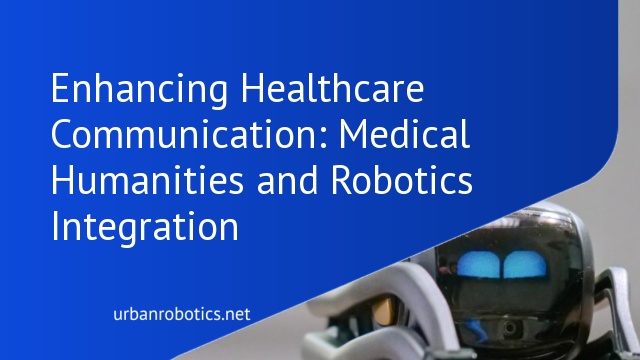Understanding Medical Humanities
Medical humanities integrate arts, literature, philosophy, and social sciences into healthcare. These disciplines enrich medical education by highlighting human experiences, values, and ethical issues in medicine. They offer perspectives that foster empathy, critical thinking, and effective communication among healthcare professionals.
By exploring patient narratives through literature or employing philosophical inquiry, students and practitioners gain deeper insights into patient experiences. This enriches doctor-patient interactions. For example, literature helps reveal the emotional impact of chronic illness, while philosophy challenges ethical decision-making.
Integrating medical humanities into robotics enhances healthcare communication. Robots programmed with empathy, drawn from medical humanities, can better support emotional and psychological needs. Our goal is to ensure robotic caregivers, guided by humanistic principles, offer compassionate interactions, promoting genuine patient connections.
This interdisciplinary field fosters a holistic approach. It aligns robot efficiencies with the depth of human compassion, ultimately improving patient outcomes. Understanding medical humanities is crucial for future healthcare advancements.
The Role Of Healthcare Communication
Effective communication in healthcare is crucial for ensuring patient care and satisfaction. Integrating medical humanities with robotics can revolutionize interactions in this field.
Importance Of Effective Communication
Effective communication impacts diagnosis accuracy, treatment adherence, and overall patient satisfaction. Patients feel valued and understood when healthcare professionals engage in active listening and clear dialogue. According to the Journal of General Internal Medicine, good communication also reduces clinical errors and improves safety. Coupled with robotic systems, which provide consistent and precise information, personalized communication becomes more attainable.
Challenges In Traditional Methods
Traditional communication methods often face several barriers like time constraints, cultural differences, and emotional fatigue among caregivers. A 2018 study in BMC Health Services Research found that over 30% of patients reported communication issues with their providers. Additionally, human caregivers may struggle with delivering constant compassionate care due to burnout. By integrating robotics, we can mitigate these challenges while still focusing on the human elements essential for effective patient interaction.
Robotics In Healthcare
Robotics is playing an increasingly significant role in healthcare, bolstering both efficiency and patient care quality. These advancements help bridge gaps in traditional methods, integrating technology seamlessly into medical practices.
Technological Advancements
Advanced robotics, artificial intelligence, and machine learning are transforming healthcare. Surgical robots, for instance, enhance precision and reduce recovery times. Autonomous robots assist in hygiene with tasks like disinfecting rooms, ensuring higher standards of cleanliness. Wearable robotic devices help in physical rehabilitation by aiding movement and providing real-time feedback.
Current Applications
Robotics in diagnostics offers significant benefits. Robotic systems analyze complex data, aiding in early disease detection. Companion robots support mental health by providing interaction and monitoring emotional well-being. In pharmaceutical settings, robots manage medication dispensing, ensuring accuracy and reducing human error. These applications showcase how robotics improves various facets of healthcare delivery.
Integrating Medical Humanities And Robotics
Combining medical humanities and robotics enriches healthcare communication. This integration fosters a holistic approach, focusing on empathy and technological efficiency.
Benefits Of The Integration
Enhanced patient engagement stems from empathetic interactions through robots equipped with medical humanities principles. Communication robots can act as compassionate companions for patients, reducing loneliness and stress. Efficient diagnostics can be achieved by leveraging robots’ precision and medical practitioners’ humanistic insights, leading to early and accurate disease detection. Better caregiver support results, as robotics reduce the burden on healthcare providers, allowing them to focus on patient-centered care and emotional support.
Case Studies And Real-World Examples
The PARO robotic seal, used in geriatric care, exemplifies the successful integration of medical humanities and robotics. This companion robot provides emotional support, reducing anxiety and agitation in elderly patients. Another instance, Pepper the humanoid robot, aids in pediatric care by comforting children with its social and communicative capabilities. In rehabilitation, the SoftBank Robotics’ NAO robot helps stroke patients regain motor skills by combining therapeutic exercises with engaging interactions, demonstrating the synergistic benefits of this integration in real-world settings.
Future Prospects
The fusion of medical humanities and robotics holds significant promise for the future of healthcare communication. Advances in technology and an increasing focus on patient-centered care drive this integration forward.
Emerging Trends
Developments in AI and machine learning enhance robotic capabilities. Personalized care becomes a reality with robots analyzing patient data to offer tailored support. Telepresence robots, like those used in remote consultations, bridge the gap between providers and patients. Enhanced natural language processing enables robots to understand and respond to patients more effectively, improving interaction quality.
Ethical Considerations
Using robots in healthcare raises important ethical questions. Privacy concerns emerge as robots collect and process sensitive patient data. Maintaining patient dignity and ensuring robots are used responsibly remains critical. Ethical frameworks must evolve to address these challenges, safeguarding patient rights and ensuring trust in robotic systems. Balancing technological innovation with compassion is essential for ethical progress in this field.
Conclusion
Integrating medical humanities with robotics in healthcare communication offers a transformative approach to patient care. By merging empathy with technological efficiency, we can enhance patient engagement and improve diagnostic precision. Communication robots like PARO, Pepper, and NAO have already shown success in various healthcare settings, providing emotional support and reducing patient stress.
As technology advances, the potential for personalized care through AI and machine learning grows, making robots even more effective in patient interactions. However, it’s essential to address ethical considerations to ensure patient data privacy and dignity. Balancing innovation with compassion will be key to achieving ethical progress in healthcare robotics.





